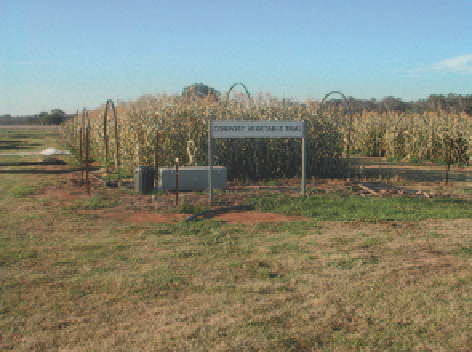Agriculture Reference
In-Depth Information
Fig. 7.7
Sweet Corn (crop
10), just prior to harvest at
the CROA long term field
experiment
7.3.1
Agronomic and Economic Impacts
The marketable yield data (fresh weight in t ha
−1
) from the first five crops of the
field trial revealed that the large one off application of 125 dry t ha
−1
of compost as-
sociated with the full compost treatments (T2 and T5) induced a crop yield response
which matched the farmers practice treatments (T1 and T4) for four of the first five
crops and exceeded it for one crop (Chan et al.
2008
,
2011a
,
b
). No significant dif-
ference (
p
< 0.05) was found between the mean yields of farmer practice and full
compost treatments for crops namely broccoli, eggplant, cabbage and leek whilst
the yields of the full compost treatments for capsicum or bell pepper and was found
to be 22 % higher than that of the comparable farmer practice treatments (Chan et al.
2008
,
2011a
,
b
). Over the period of the first five crops, the compost treatment also
resulted in significant savings from reduced fertilizer use compared to farmer prac-
tice (Table
7.2
), with a 36 % saving in urea as well as a 100 % saving for K and P
fertilizers (Chan et al.
2011b
). The economic analysis of the yield and inputs for the
first five crops determined that the full compost treatment had a benefit cost ratio
(BCR) of 1 compared to farmer practice, indicating that this compost practice was
very close to breaking even for the first five crops (Chan et al.
2011b
). Although, a
BCR of 1 on its own may not seem that encouraging for those considering practice
change, it was thought at the time, that given the additional benefits measured for
soil quality (Chan et al.
2008
) and the environment with reduced water quality risk
(Chan et al.
2010
), that this was a fairly encouraging result. In contrast, the mixed
compost treatment (½(half compost; half chemical fertilizer) with a one off ap-
plication of 62.5 dry t ha
−1
of cGO compost at the start of the field trial, although
matching the yields of the farmer practice treatment for the first four crops, had a
significantly lower (
p
< 0.05) yield for the leek crop which was 64 % of that of farm-
ers practice (Chan et al.
2008
,
2011b
). This resulted in a negative BCR of − 1.15
for the economic analysis of the mixed compost treatment versus farmer practice,

